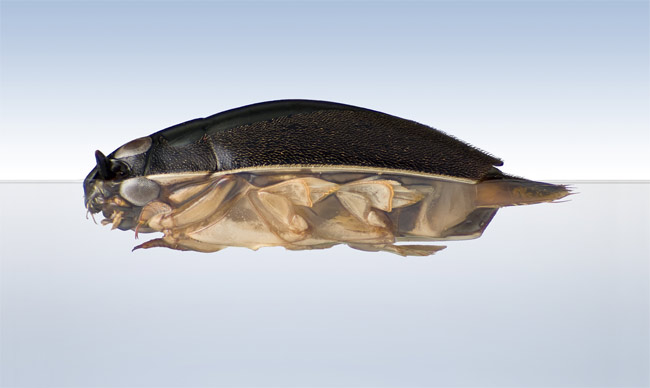This Beetle Really Rocks

A new species of beetle that appears as if wearing a tuxedo has been named in honor of the late rock 'n' roll legend Roy Orbison and his widow Barbara.
Entomologist Quentin Wheeler of Arizona State University announced the discovery and naming of the beetle, now dubbed Orectochilus orbisonorum, during a Roy Orbison Tribute Concert on Jan. 25.
The ending of the species name, "orum," denotes it was named after a couple. If the beetle were just named after Roy it would end in "i," and for just Barbara, the name would end in "ae."
Barbara Orbison, who attended the concert along with Orbison's sons Wesley and Roy Kelton Orbison Jr., remarked on her appreciation for the new species name. "I have never seen an honor like that," she said.
To mark the occasion, Wheeler presented Barbara with an original work of art titled “Whirligig." Completed by ASU scientist and artist Charles J. Kazilek, the painting included nine images of a whirligig beetle on cotton watercolor paper.
"The style of the print is [Andy] Warhol meets Carl Linnaeus," Wheeler said, referring to the pop art icon and the father of taxonomy (the method of classifying living things).
Less than a quarter-inch long (five millimeters), O. orbisonorum belongs to the Gyrinidae family, a group of beetles that typically live on the surface of the water.
Sign up for the Live Science daily newsletter now
Get the world’s most fascinating discoveries delivered straight to your inbox.
Called whirligigs because they swim rapidly in circles when alarmed, the beetles have "divided" eyes that can see both above and below the water. A band of material separates the eyes so that on first glance you'd think the insect were four-eyed.
Unlike other members of the Indian Gyrinidae, however, this one has a white underbelly due to a clear cuticle through which the white internal tissues are easily visible. Its top surface is shiny black with dull patches covered with dense, tiny hairs. "The contrast between the two areas is visually very stunning," Wheeler said.
The beetle's elegant appearance is one reason for the naming. "It almost looks like it's wearing a tuxedo," Wheeler said.
In 2005, Wheeler and his colleague Kelly Miller of the University of New Mexico discovered 65 new species of slime-mold beetle in the genus Agathidium. They named one of the beetles after Darth Vader and others for President George W. Bush, Vice President Dick Cheney and former Secretary of Defense Donald Rumsfeld.
The new species will be detailed in an upcoming issue of the journal Zootaxa.
- Top 10 Amazing Animal Abilities
- Vote Now: The Ugliest Animals
- Image Gallery: Backyard Bugs
Jeanna Bryner is managing editor of Scientific American. Previously she was editor in chief of Live Science and, prior to that, an editor at Scholastic's Science World magazine. Bryner has an English degree from Salisbury University, a master's degree in biogeochemistry and environmental sciences from the University of Maryland and a graduate science journalism degree from New York University. She has worked as a biologist in Florida, where she monitored wetlands and did field surveys for endangered species, including the gorgeous Florida Scrub Jay. She also received an ocean sciences journalism fellowship from the Woods Hole Oceanographic Institution. She is a firm believer that science is for everyone and that just about everything can be viewed through the lens of science.









